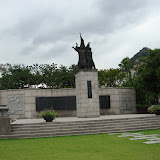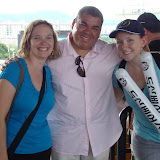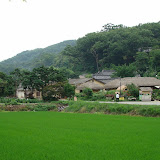Click on the image above to view the albumFriday 16 July 2010Today was intense.
Most of us woke up feeling a little edgy this morning. People visit the DMZ nearly every day without incident. But that doesn’t mean it is safe. We were about to go to one of the most tense military locations on the planet! We were all excited, but a little on edge.
I have tried to make sure this is as accurate as possible, but I do apologize if I have made a mistake.
Once we reached Imjingak village and we looked over tall barbed wire fences into an expanse of green…we knew we were about to head into the thick of it. We were allowed to take plenty of pictures here, but soon all of the rules were going into effect. To visit the DMZ you have to pre-register with South Korea’s government (with your passport) and there’s only a few agencies to work arrange your visit through. I may be wrong, but it’s my understanding that Koreans living in the Republic of Korea (South) can only get as far as Imjingak, the northernmost town.
We had ten or fifteen minutes in the village and then headed onto the first checkpoint where they looked at the zoom on our cameras and checked our passports. Then the rules that had been shared with us started to go into effect as we headed to Panjunmon, also called the “JSA” or Joint Security Area, which is the area monitored jointly by the United States, the United Nations, and the Republic of Korea. We pulled up to the JSA and were briefed in a building at Camp Bonifas, which is named after Captain Bonifas, who was killed by North Koreans during the Axe Murder incident. Captain Bonifas and a group of men were chopping down a tree that was obstructing their view of the bridge that led to North Korea. The North Koreans came across the bridge, overwhelmed the men, and murdered Captain Bonifas. The motto of the JSA is “In Front of Them All” (meaning, they’re the first line of defense for the people living in the Southern half of Korea).
So we entered Camp Bonifas and received our briefing. These are some of the rules we had to abide (some of these were disclosed before we left, some later):
1. You must wear long pants (no jeans), a collared shirt, and closed toe shoes.
2. For the shoes it’s recommended you wear ones you can run in.
3. No gum or drinking any liquids
4. Once past the checkpoint, no standing up on the bus
5. Do not put your hands in your pocket
6. Do not wave or point at anything or anyone
7. No photographs, unless told otherwise
8. Go only where the guide allows you to go – most of the green fields contain live mines
9. Do not speak/shout to anyone (meaning N Korean soldiers, or anyone on the other side)
10. If you consumed any alcohol prior to visiting the DMZ area, you cannot participate
11. No video recorders
12. Do not touch anything in the conference room
13. You must walk in two single file lines
14. You can carry nothing but your camera with you, no case, no purse, nothing that could hold weapons and make you seem suspicious to the North Koreans – meaning you had to find a place to put your passport and money…I used my money belt.
15. You must sign the Visitor Declaration form that recognizes “the visit to the Joint Security Area at Panmunjom will entail into a hostile area and possibility of injury or death as a direct result of enemy action.”
Wow. To top it off, in one of our previous lectures we talked about North and South relations and were reminded of the recent Cheonan incident, the two women who were hiking and were arrested, and the S Korean tourist who was shot to death by N Korean military on a beach.
It’s tricky to explain all of the details of what happened after the briefing – it all happened pretty quickly, tensions were high, adrenaline was pumping a little, and so it’s kinda tricky to recount, but here’s the highlights:
We exited the JSA briefing area with our new UNCMAC Guest badge…that had the UN logo on it!!, and boarded a bus…only it wasn’t our bus, it was a military bus that was driven by a soldier. We now had an assigned guard standing at the front of the bus that was from the Republic of Korea. We were told to do everything he said. (The ROK guys have to be bigger than the average soldier, are chosen based on their appearance, their ability to fluently read and write in English and Korean, military performance, and must have a black belt in a martial art).
We drove for a while…suddenly the South Korean flag was waving on a pole as we caught a glimpse of the South Korean village of Taesong-dong (the South Korean village of people who didn’t want to relocate when the Military Demarcation Line was drawn). As we drove on the road there were two big blue poles that we drove between and we were told we were officially in the de-militarized zone – which they reminded us is ironically very militarized. Then, off in the distance we caught a glimpse of the red North Korean flag waving over Propaganda Village – wow! Fun fact? North Korea erected a flag pole in their propaganda village, the South Korean village put a boastingly tall flag pole (around 100 m) up, and to best them North Korea constructed the world’s tallest flag pole at 160 m in height.
We pulled up to the Freedom House and were ushered out of the bus and into two single file lines where we were march up and down some stairs and suddenly found ourselves outside again, this time facing conference row with the North Korean building mirroring on the other side. Wow!
I only saw soldiers on our side, but they looked fierce. We entered the conference room and they shut the door. We had two soldiers in there with us, one stood in the center of the room the other with his back to the door North Korean soldiers would enter. We were told touch nothing, do not go past the edge of this table, and we had a few seconds to take pictures – go! In succession there were 30-40 cameras powering up, lens caps popping off, and clicking commencing. I was technically past the Military Demarcation Line that ran through the center of the building and was standing in North Korea!
I managed to get a few pictures – I even dared to step near the edge of the table and our tour guide took our picture. And before I knew it “No more photos!” was shouted, and out of the corner of my eye I saw three North Korean soldiers goosestepping towards our building – I think I audibly gasped, felt my heart skip a few beats, and had a personal yikes moment. It was all real. I was suddenly incredibly aware that I was standing at one of the greatest military hotspots in the world. W were rushed out of the room with no explanation and lined up on the steps of the Freedom House, facing North Korea.
Suddenly, there were several North Korean soldiers between the MDL (the line) and their building and a flock of tourists came out onto the steps and started snapping many pictures of us. …Maybe that’s why we were supposed to dress nicely (long pants, no jeans, and a collared shirt generally spells out business attire). Hmm. Our guide suddenly said we could take photos and again we all started clicking away. “No photos” was commanded again and we were quickly led back through the building onto our bus. We drove around the building, and when we were driving by conference row we were again given photo permission…but it was taken away in seconds.
We had another “photos” and “no photos” moment when we pulled up to the Bridge of No Return that links N and S Korea, and is also the site of the Axe Murder Incident. As we drove through the demilitarized zone there was a beautiful flock of white birds (the DMZ is essentially a no man’s land and has become a haven for bird life since it is all undisturbed territory) and our guide again let us take pictures as the bus idled, but we had to be given permission to stand. “No photos.” We again drove within sight of the propaganda village with the gigantic red flag waving overhead. But, no photos. (I have since researched this, because I had a friend who went to the DMZ and had photos of the village. Typically when at the Freedom Building tourists are allowed to climb up a pagoda that has an observation deck and take pictures from above. We were not given this opportunity. I think it’s because of the sinking of the Cheonan a few months ago, but I have not confirmed this yet.) The tourists on the North Korean side went up to an upper level of their building and took pictures...they don't exactly have to worry about a US or ROK soldier arbitrarily shooting them.
We whizzed through the rest of the demilitarized zone, crossed a very creepy as-far-as-the-eye-can-see stretch of fencing and barbed wire, and soon found ourselves driving past the blue poles again. We pulled up to the JSA area and piled into the gift shop where we made a mad run on all of the goodies. I am very proud to say I am now the owner of a piece of the DMZ (I have barbed wire) and a few other cool things that will make my history classes even cooler. :)
They had switched out our buses while we were in the gift shop (they were very ninja with the bus switching) and we were headed back to safer areas. As exciting as it was we all breathed a sigh of relief as we passed the last barbed wire checkpoint and were allowed to take pictures again. Whew.
We had a great lunch – another meal where we got to cook our own beef on a table grill and had a free mid-afternoon in Seoul. I took a nap and accidentally ended up in a coma in which an alarm clock, two calls from the friend I was supposed to meet, and another friend banging on my door could not rouse me. Yikes. …I guess traveling since the night of June 20th is catching up with me. I'm sure the adrenaline rush didn't help either (although, I am relieved to say, this rush was not nearly as severe as the adrenaline rush I had during the bomb scare in the Israeli airport)
Today was an awesome one – I was always jealous of people who went to Berlin before the wall fell. Hopefully things will improve between North and South Korea and I will witness the reunification in my lifetime.









.JPG)













